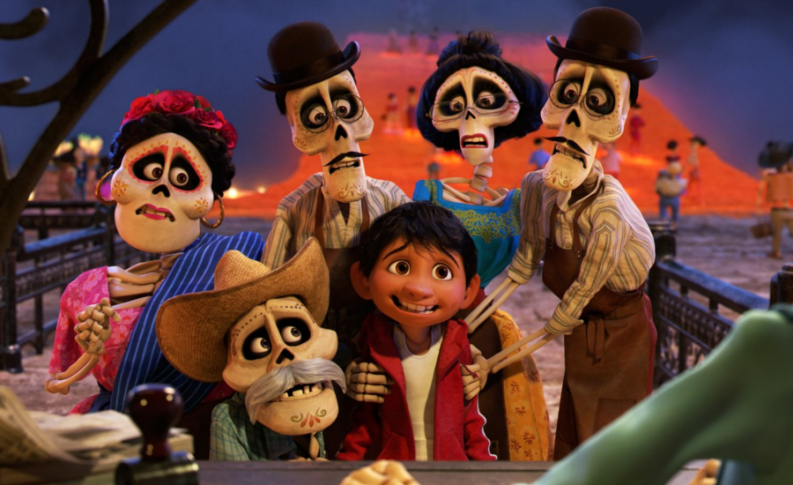Martha Sanders discusses Pixar’s step away from monsters and robots and much needed steps towards diverse representation in their films.
Although it is commonplace to see articles criticising Disney films for cultural misrepresentation, whitewashing and racial stereotyping, it is rarer that we hear the same of Pixar. Despite this, Pixar has not yet produced a single film with a non-white protagonist. Pixar supporters may defend this by pointing out that only five of Pixar’s eighteen films have involved human characters; the rest contain cartoon depictions of cars, monsters and robots. However, none of the voice actors for any of these parts have been anything but- you’ve guessed it- white.
Even within the non-human realms of Pixar’s animations, ‘whiteness’ is often portrayed as the norm. Andy, the owner of the toys in Toy Story, along with his family, is white; Boo, the toddler into whose room the monsters of Monsters Inc. appear, is white and the only three humans to have speaking parts in Wall-E are all white. This is not to say that Pixar’s films are completely whitewashed; one of their most prominent characters of colour is Frozone from The Incredibles. Unfortunately, this character, voiced by Samuel L Jackson, can be seen to fulfil the ‘cool black comic relief’ stereotype.
Although he is not the main character, Pixar somewhat raised their game in their 2009 film Up, with the portrayal of Asian-American boy scout Russell. They also showed some diversity in their casting of Mindy Kaling (who is of Indian descent) as the emotion, Disgust, in the 2015 film Inside Out. While it is clear that the company has made progress in terms of representation, this lacklustre show of diversity makes the release of their new animation based on the Mexican tradition of ‘Dia de los Muertos’ significant.
Pixar’s new film will tell the story of 12-year-old, aspiring musician Miguel who attempts to prove his musical talent (despite his family’s mysterious ban on music) and in doing so will end up in the land of the dead. The cast is comprised of Mexican actors and actresses and, to ensure authenticity and avoid insensitive misrepresentation, the producers took advice from cultural experts. Having already premiered in the USA, the film has received positive reviews with Vanity Fair describing it as a ‘Love Letter to Mexico in the Age of Trump’.
The Walt Disney Company has a poor record when it comes to depicting race and ethnicity; they have been criticised for perpetuating racial stereotypes and clichés. It has been noted by critics that their past films have been under-researched and insensitively cast. Coco is a chance for the company as a whole to push narratives that promote inclusivity and empathy.
It has not been a completely smooth ride for Coco which was originally titled ‘Dia de los Muertos’ or ‘Day of the Dead’. The Walt Disney Company came under fire for attempting to trademark the term in 2013 with critics calling them out on their disrespectful attempt to capitalise on a significant, Mexican, cultural tradition. However, they turned this around by employing the very people who criticised them to act as cultural advisors.
Coco is so important to Mexicans because we don’t get alot of representation on screen by Disney/Pixar and for them to celebrate our culture like that makes it a must see 🇲🇽✊🏽
— Mario Juárez (@youngdonjuarez) November 18, 2017
After the recent success of Disney’s Moana, Coco appears to have taken a leaf out its book. Moana has been lauded by critics for the attention to detail in representing the indigenous people of Polynesia. They took multiple research trips and spent five years endeavouring to accurately represent the people depicted. This has been so well received by critics and on social media that it has massively attributed to the film’s success. It is hard not to take the cynical view that the company are capitalising on cultural authenticity; the buzz it creates on social media, in the midst of news stories regarding whitewashing of Hollywood, is an undeniably superb form of free marketing for Disney.
Nonetheless, it cannot be a bad thing that our screens are becoming more diverse: large screen depictions that reflect the broader makeup of society can only help to encourage tolerance and understanding in a time when racial divisions are rife. At the time of conception in 2010, the producers could not have foreseen the political landscape into which the film would arrive but in a time of Trump and Brexit this film could not be more welcome. As a company known for pushing the boundaries both technologically and thematically, Pixar’s new film Coco, though long overdue, could be the film adds some colour to Pixar’s whitewashed palette.
Martha Sanders
(Image courtesy of Walt Disney Pictures)

